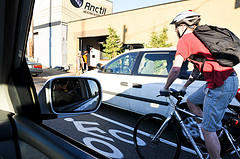This year, Washington State lawmakers will consider a new safe passing law. The bill, House Bill 1018 (PDF), is just one part of what’s been dubbed as the “Mutual Responsibility Bill.” It appears to have support from both sides of the aisle (in total, eight democrats and three republicans support it) and seems to stand a better chance of passage than a similar attempt in 2008.
What’s in Washington’s bill, and how does it compare with Oregon’s existing safe passing law?
According to Bicycle Alliance of Washington Policy Director Dave Janis, bipartisan — and bi-modal — support for HB 1018 is key. “In previous attempts [for a safe passing law], we kept hearing ‘what are cyclists’ responsibilities in passing’,” Janis said in a phone interview earlier this week. The failure to address the duties of a person riding a bicycle in a passing situation, he added, created insurmountable concerns among legislatures and law enforcement with the 2008 bill.

In the current bill, the mutual responsibility of road users on both sides of the windshield were incorporated to create a more “comprehensive bill,” that should be widely supported, said Janis.
Although the bill is subject to amendments, its current form is indeed comprehensive.
To highlight a few key aspects of the bill, it:
- Defines a safe passing distance of bicycles by motorists as “three feet lateral separation between the closest part of the motor vehicle and the closest part of the bicycle or pedestrian,” when a motor vehicle is traveling less than 35 m.p.h. and five feet at greater speeds.
- Mandates “every driver of a motor vehicle shall exercise due care to avoid colliding with any bicyclist.”
- Specifies that cyclists traveling on a roadway slower than the “legal and normal flow” of traffic must ride as far right as “judged reasonably safe by the bicyclist.”
- Specifies that a cyclist traveling slower than the “legal and normal flow” ride in the paved shoulder, or designated bike lane when traffic is present and “such use is reasonably judged safe by the bicyclist.”
- Provides a partial list of unsafe conditions that may require a cyclist to ride in lane positions other than the far right. The list includes road hazards, the potential to be doored and being passed at “less than a safe distance.”
- Requires that bicyclists yield to pedestrians when riding on sidewalks, crosswalks, multi-use trail or trails but, does not relieve a pedestrian of the “of the obligation to exercise due care.”
Washington’s bill differs greatly from Oregon’s law, ORS 811.065, in several significant ways.
Although the Oregon code defines ‘safe distance’ as a distance “sufficient to prevent contact with the person operating the bicycle if the person were to fall into the driver’s lane of traffic,” it exempts a majority of day-to-day passing scenarios.
In contrast to the very concept of safe passing, the Oregon code allows for a driver going 20, 30 and even 35 mph to pass within inches of someone riding a bicycle. It also keeps it legal for semi-trucks, with large and dangerous side mirrors, to whizz by at any rate of speed, so long as the person on the bike is in a marked bike lane.
Motor vehicles traveling “[a]t a speed not greater than 35 miles per hour” are exempt from Oregon’s passing requirement. So are motor vehicles driving “[i]n a lane that is separate from and adjacent to a designated bicycle lane.”
So far, relevant statistical data that would back up a need for these myriad exceptions to the law has not been found, which could lead one to believe that they were simply compromises in order to get the bill passed.
Whether Washington’s law survives the legislative sausage-making and leads to truly “safe passing” remains to be seen.


